H. P. Friedrichs (AC7ZL) Homepage
Radio Room
Going To War With Static Electricity
Introduction
There is something ironic about our civilization's preoccupation with finding energy sources, given the fact that everything in the universe is virtually floating in a sea of electricity. However, as is so often the case, the devil lies in the details. The source, quantity, and nature of that electricity can determine whether it's actually useful, merely a nuisance, or a serious hazard. Thus, the "juice" developed at a power plant, directed through wires to the filament of the light bulb in your desk lamp, is a good thing. A bolt of lightning, rattling between the sky and the tip of your ham radio antenna is not.

Lightning in the skies over Tucson, Arizona (by AC7ZL)
Most hams are well aware of the threat posed by lightning, and most (I would hope) have taken some steps to mitigate the risk to their stations. Just the same, I suspect that few appreciate that other natural processes can generate substantial potentials on an antenna, and do so without so much as drop of rain or a cloud in the sky.
For your amusement, I submit this story of military operations in a far-off place, an antenna, and two friends, half a world apart, with a common interest in radio.
Sgt M's Shocking Story
Several years back, I authored a couple of radio-related books. Sgt M, deployed in Iraq at the time, contacted me via email regarding these books, and we subsequently became good friends. If you are a regular reader of articles on my web site, you have already met Sgt M. I've written about him before in my article If Rigs Could Talk: The TR-VP-13.
A fair amount of time has passed since then, and recent events have found Sgt M redeployed to Iraq. We try to keep in touch, and I always find myself fascinated with the stories he has to tell. I will let him explain a situation that occurred earlier this year, the basis for this article, in his own words:
"My team is working almost exclusively in a small compound East of the Tigris River with the exception of a few days off for 're-fit / decompression' on a fairly large base once a week. We have some very nice tents to live in on this base, something along the lines of a 25-dollar-a-night motel minus the booze and prostitution. Our sleeping areas are separated by sheets of ply wood and makeshift doors, the floors are made of wood to support this type of structure so you can keep your 'nest' relatively clean with a good sweeping now and then.
Surprisingly enough, we have a very strong AC system that consists of a large tube suspended high in the center of the tent with holes in it that allows the cold air that is blowing though it to push down in concentrated spots throughout the tent, namely the spots where we are sleeping. This system is maintained by local contractors and I can honestly say they do a great job of keeping up on the thing (although when the temp. was around 120 and they waited until mid day to do services we would take bets on which one of them would fit the best in our now quickly thawing deep freezer).
Surrounding the tents are rows of 'Tee Walls,' something along the lines of 12-14 feet tall roughly poured concrete barriers that enclose our tents to prevent any indirect fire / shrapnel from tearing through the very thin nylon/rubber walls of our sleep area.
We always leave someone behind every time we move back out to our compound to keep an eye on our stay-behind equipment. This is not a bad gig, you get time away from the team to recalibrate your social bearing so to speak (we are an 11 man team in tight living conditions, so alone time is a premium).
On the northern side of the tent about 15 feet above the tee walls stands my antennas, a QUEM aluminum antenna mast (33' fully extended) is lashed to the side of a Tee-Wall right behind my sleep area. This mast supports two antenna systems, an OE-254 Omni Directional Antenna at the top (VHF) and a couple feet below, a balun for an inverted 'V' dipole cut for 40 Meters (I snuck that one up there for my Elecraft KX1).

A typical OE-254 set-up
The OE-254 feed cone assembly is fed with RG-213 and the Dipole is fed with RG-223 with both cables running into my room where I keep a couple of radios on hand to talk with my team on their way out and back from our outside compound (I leave access to my room for anyone staying back so they can do the same).
It wasn't until one of my rotations to stay back that I realized something magical was happening during high winds and dusty conditions to my antenna cables. I suppose I had never had to deal with this situation before because a radio stack would always be present on the receiving end of the coax therefore providing the cable with a good grounding system. When my extra radios are not in use I keep them in a "go" bag with all of the possible portable options, antennas, batteries, hand mikes etc… so the cables were left exposed, coiled nicely and hung on the tent wall.
Early one morning on one of my rotations back at the tent I woke up to some pretty strange sounds. It almost sounded like a power strip that had a plug that was not quite pushed in all the way that was just close enough to the contacts to allow electricity to 'crackle' across. This sound would intensify until a couple of large 'snaps' were heard and then nothing for a few minutes and then the cycle would start again. The weather that night was windy and very dusty, the tent was all over the place already so it was fairly loud for me to have woken up to it.
I got up to investigate, my room not being very large made it very easy to zero in on the noise... after seeing the cables at the site of the noise I found myself reaching toward them, it was fairly dark and only bits of light made it through to my room from a small bulb that hung in the front of the tent entrance. The wind was moving the tent around so the light from the bulb kept changing positions swinging with the motion of the tent.
My hand must have been at least two feet from the cables when I got a 'pop', I saw it that time, a blue twinkle across the side of the tent where the cable was and a nice streak that reached out and touched my hand, it stung a bit, the whole surprise of getting a shock in the early morning had more effect then the electrical shock itself I think, didn't see that one coming. I moved back away from the corner the cables were in and crawled back into bed, I figured I was far enough away from those troublesome cables to not have to worry about it until I got up a couple hours later besides they had been doing this ever since I put them up I was just never around to hear it or see it."
The Culprit
Everyone knows that under dry conditions, rubbing certain materials together can produce an electric charge. The electrical charge produced as the result of these mechanical effects is called triboelectricity. If you've ever shuffled across the floor in your favorite fuzzy rabbit slippers, and then received a shock from a doorknob, you know what I'm talking about. Similarly, high potentials of many thousands of volts, can be created simply by ripping a length of cellophane tape from its spool. Believe it or not, tape-ripping can produce such high voltages that research is now underway to study the application of this process to the production of medical x-trays!
Particles in a dust storm are in violent mechanical motion. They bang together, fly apart, and rub against each other. While this might be mistaken for the mosh pit in the front row of a heavy metal concert, what I am really describing are the ideal conditions for the creation of triboelectricity.
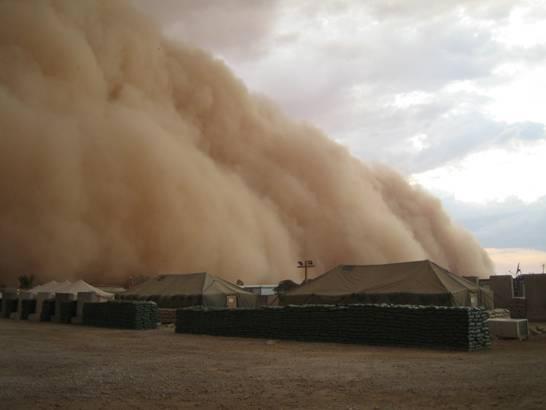
An example of an Iraqi dust storm (from snopes.com)
In Sgt M's case, the electrical charges generated by sand and dust in motion was obviously collected and accumulated by his antenna system, and subsequently carried into his tent. When those charges exceeded the breakdown voltage of the air, the antenna system discharged the accumulated electricity from the center conductor of his coax to the grounded shield. The charge built up again, followed by another discharge, and process would repeat indefinitely. At least once, according to his account, the charge on the antenna dissipated itself through Sgt M's hand!
Sometimes, the triboelectric effects associated with particles can have dire consequences. The military recognizes blowing dust as a potential threat to communications equipment and computers. NASA observes a "triboelectrification rule" that prevents them from executing a launch if certain types of clouds exist overhead. Triboelectric discharges have even caused fires and violent explosions in grain silos.
On behalf of my friend, I decided that it would be interesting to see if I could knock together a simple accessory for his radio setup that would "bleed off" the accumulation of charges on his antenna.
Engineering a Solution
Static charges, while often high in voltage, typically represent a high-impedance source. Therefore, current is relatively low, and they can easily be dissipated and controlled by appropriate grounding measures. The question is what constitutes "appropriate," and to answer this, one must consider the pros and cons of any potential solution.
One way to manage Sgt M's situation, I thought, would be to install a grounded antenna switch between his cable and his radios. The switch could be set up to ground the antenna whenever it is not in use. This is actually a good idea, and is part of the system I use in my own ham shack to suppress the accumulation of charges on my antennas. The downside is that this only works if you remember to throw the switch to the ground position. Conversely, if you neglect to throw the switch back to the ungrounded position before you key up your radio, you run the risk of damaging the rig through an extreme SWR condition.
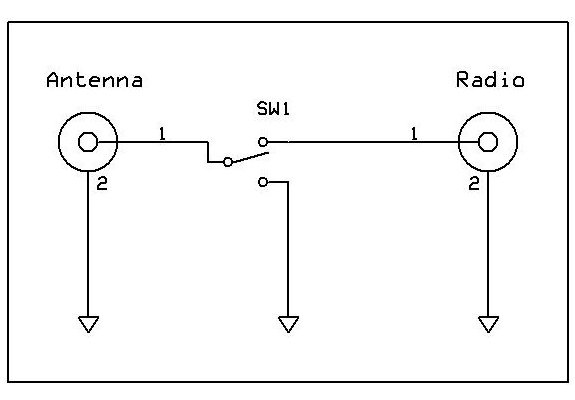
Switch in the down position grounds the antenna
Even if you do manage the switch position faithfully, the radio is essentially unguarded while in use. I would expect that military equipment is engineered to tolerate a fair amount of abuse in the field. On the other hand, it wouldn't surprise me if the repeated application of tens of thousands of volts (to the input of an instrument designed to sense signals in the microvolt range) could lead to eventual degradation and failure.
Another way to bleed electrical charges on an antenna is to add shunt devices to the antenna circuit, so as to direct those charges to ground. The benefit of such devices is that they are always present, they do not require operator intervention, and they function even when the radio is attached and in use. The caveat is that is the shunt device must not interfere with the radio equipment when it is transmitting.
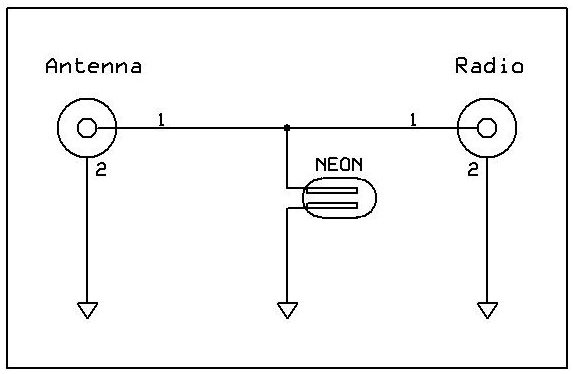
Neon bulbs, like the NE-2, have been used to protect receiver inputs in certain designs
Gas discharge tubes are sometimes used to shunt antenna lines to ground, and I've seen homebrew arrangements where NE-2 neon bulbs were used in this capacity. The terminals of a neon bulb represent an open circuit until a voltage is applied that exceeds the bulb's striking voltage. The rarified neon gas inside breaks down and ionizes, and the neon bulb becomes a conductor. While this can work well for a receiver-only rig, trouble can arise when you key up to transmit. Send a 100-watt signal to a 50-ohm load, and you may see 70 volts on that line. This is precariously close to the 90-volt striking voltage of the bulb. If the SWR is anything but a perfect 1:1, the voltage can be much higher, and you're likely to smoke that neon bulb the first time you key up.
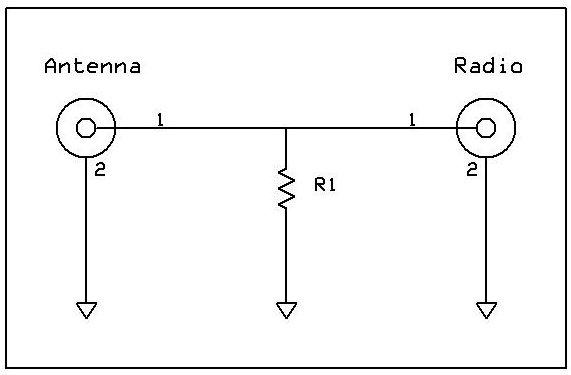
A resistive shunt will drain off static charges, but you need to use the correct value and type
I also considered using a resistive shunt. If a sufficiently high-value resistor is chosen, its presence on the coax is not likely to have a deleterious effect on SWR. I've found online forum discussions between hams describing shunt resistors used to suppress electrostatic charges. One ham describes the addition of 1 or 2-watt resistors in the 10 to 100-kilo ohm range.
That said, there are two important factors to watch out for. First, you never want to use a wire-wound resistor in this application. Second, my sense is that many hams (and a fair number of engineers) tend to overlook the fact that resistors, like any other electronic component, have maximum voltage ratings associated with their use. Exceed that rating, and you risk damaging the resistor over time, even if you never dissipate enough power to actually "smoke" it. Pull the data sheets on common resistor families, and you may be surprised at how low the specified maximum ratings can be.
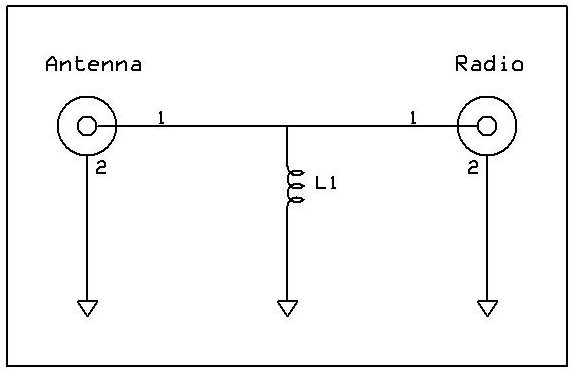
Draining static charges with an RF choke
If we replace the shunt resistor with a frequency-sensitive component like an RF choke, it is possible to enjoy the best of two attributes-- a low D.C. resistance (creating a low resistance path for charges to reach ground) and a high impedance to radio frequency currents (the signals you don't want to ground.) This is the approach I chose to take.
I love hamfests, and I'm not bashful about carting home odd assemblies and electronic carcasses that can be stripped for parts. Not long ago, for a buck, I purchased a chunk of an old WWII aircraft transmitter. The rig was too far gone for any hope of restoration, but I was able to salvage some nice hardware, tube sockets, a couple of variable caps and some nice RF chokes. Among these was a pair of 50-millihenry, 100-milliamp chokes. "This should do," I thought.
Obviously I like to recycle parts, and this includes mechanical odds and ends like fasteners, sheet metal, and enclosures. Digging around in my junk box, I found a couple of die-cast aluminum shells that were once used to cover and shield sensitive electronics on a circuit board. I noticed that the two shields, while not intended to be used in this fashion, could be fitted together like the halves of a clamshell. I wasn't concerned about making the device watertight, so the these boxes would make a nice enclosure.

The interior of the static bleeder
Little needs to be said about fabrication. I drilled two holes in one of the shells and fitted it with BNC connectors. I drilled a mounting hole for the choke, and a hole for a ground lug.
A short, straight, copper "link" wire was soldered between the two connectors. The link was tapped with another wire, which fed the choke. The far side of the choke was connected to the grounding lug.
The two die cast shells were joined together, and the assembly got a coat of an appropriate olive-drab "army" paint. The wing nuts on the ground lug and the case bolt, like the choke, were war surplus salvage items. I paused to wonder what action these WWII components might have seen last time they were deployed, and what they might see this time around.

The static bleeder. Note the ground lug
I measured the choke's D.C. resistance at around 400 ohms. As far as static is concerned, this is a dead short to ground. At radio frequencies, a 50-millihenry choke represents a very large impedance, even at HF. I expected that the arrester would have negligible effect on Sgt M's ability to transmit and receive, but to be on the safe side, I decided to make some quick measurements.
Using some BNC patch cables, I connected the arrester between my MFJ-259 antenna analyzer and a 50-ohm dummy load. I swept the analyzer from one end of its operating range to the other, and never saw any evidence of SWR problems.


Top and bottom of the static bleeder
Good to Go
Theory is all well and good, but ultimately, the proof is in the pudding. Would my little gizmo work? Confident, I boxed it up and shipped if off to Sgt M's APO. Again, I will leave it to him to describe the outcome. Frankly, it's one of the funnier things I've read in a long time:
"Some time had gone by between my discovering this problem and you sending me the 'arrestor' so as all good neighbors do, I had to share this marvel with all of my teammates including our augmentees that worked for us from a conventional unit. We were authorized four of them from a local Cavalry Unit and of course, they were very happy to give up their best and brightest... maybe I am stretching things a bit here... we got the ones they did not want to deal with anymore, and this proved challenging on a number of levels starting with common sense.

"Goat Eyes?" (from photobucket.com)
Enter 'Goat Eyes.' This was a young man with quite a few 'issues' to say the least but what's that old saying 'you get what you pay for?' Well, he was free if that tells you anything. I gave him that name because that's just what he looked like in the face-- a goat. He didn't have the lazy eye thing going on, just a deep, non-responsive stare... almost lifeless. When addressing him I would catch myself moving from eye to eye maybe in hopes of catching a bit of movement signifying some type of understanding between us. I think that I would have focused on that eye if I ever saw any life. He could eat and sleep on his own but any other complex directives such as taking a shower or responding when his name was called seemed beyond his grasp, a very special treat to work with.
The day my box came we were all back at the tents, including 'Goat Eyes'. This was awesome, because it was also windy and dusty that day and the coax cables were 'talking'. I ran a small copper wire from one of the pieces of rebar that held down one of the sides of the tent outside. I am not sure how far in the ground it went, but I figured it would be a good starting point (breaking ground was a bear to say the least in that area, so my fingers where crossed).
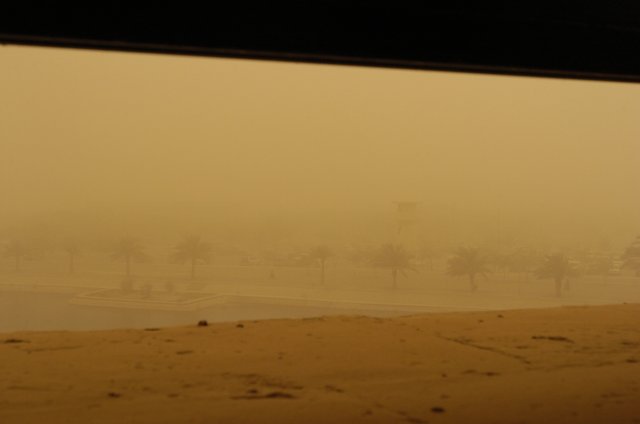
Another example of a dust storm (from www.army.mil)
Now came the tough part. With the cables barking static electricity, who in their right mind would touch them? It only took 'Goat eyes' less than a minute of walking into my room, seeing the wire, hearing the sparks and knowing that someone had to touch it, for him to be drawn to the cables. I had already hooked up the ground wire to the box and had only to screw the large RG-213 onto the adaptor that was attached to the BNC connector. He got about one foot from the cable before the first 'pop' (I think I heard him laugh a little) then another until the cable was touching the box and then... nothing, not a peep, this device worked flawlessly!
The only test that had to be done was a radio check with a distant station, I hooked up one of my radios to the 'Radio' BNC connector, called up about a fifteen kilometer shot and got a 'loud and clear.' The same could be said on my end. Thanks again for yet another fix Pete, looking forward to getting back and working some CW with you in the free world."
...No, Sgt M... Thank you... and I thank everyone in uniform who serves on behalf of the people of the United States of America.
Document Revision 1, 11/23/2009



